Sound masking
- 72 Accessible design
- 73 Ergonomics: visual and physical
- 74 Exterior noise intrusion
- 75 Internally generated noise
- 76 Thermal comfort
- 77 Olfactory comfort
- 78 Reverberation time
- 79 Sound masking
- 80 Sound reducing surfaces
- 81 Sound barriers
- 82 Individual thermal control
- 83 Radiant thermal comfort
- P4 Impact reducing flooring
79. Sound masking
To reduce acoustic disruptions and increase speech privacy by implementing sound masking into the building design.
Ambient silence can be just as distracting as a loud environment as it highlights acoustical disturbances and decreases speech privacy. Overhearing private conversations is reported as a specific cause of employee acoustic dissatisfaction in open offices. Sound masking systems supply a low level of background noise to provide workers with a degree of confidentiality in their communications and can decrease distraction associated with aural interruptions.
All open workspaces use the following:
If sound masking systems are used, sound levels fall within the following range, when measured from the nearest workspace:

Applicability Matrix
| Core & Shell | New & Existing Buildings | New & Existing Interiors | |
|---|---|---|---|
| Part 1: Sound Masking Use | - | O | O |
| Part 2: Sound Masking Limits | - | O | O |
Verification Methods Matrix
| Letters of Assurance | Annotated Documents | On-Site Checks | |
|---|---|---|---|
| Part 1: Sound Masking Use | MEP | ||
| Part 2: Sound Masking Limits | Performance Test |
| 79.1.a |
The General Services Administration's Sound Matters recommends that sound masking should be considered a technique to achieve acoustic comfort in contemporary offices. |
| 79.2.b |
The General Services Administration's Sound Matters recommends sound masking at 40-42 dBA for private offices. |
| 79.2.a |
The General Services Administration's Sound Matters recommends sound masking at 45-48 dBA for open plan workspaces. |
